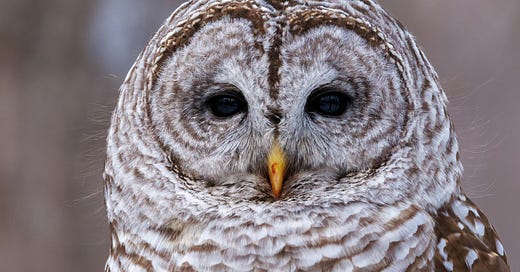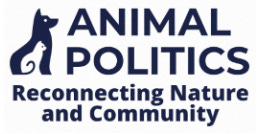Animal Politics: Controversy Over Barred Owl Management
Rethinking Conservation: Protecting Owls Without Killing
In the verdant forests of the Pacific Northwest, a contentious debate echoes beneath the canopies where two iconic owl species, the northern spotted owl and the barred owl, compete for territory. At the center of this debate is the U.S. Fish and Wildlife Service's (USFWS) startling proposal to kill nearly half a million barred owls to protect the northern spotted owl, which is classified as "threatened" under the Endangered Species Act. This drastic measure has sparked strong objections from over 120 wildlife protection and animal welfare groups, who argue for Compassionate Conservation—a humane approach that aims to safeguard biodiversity while respecting the welfare of individual animals.
Wayne Pacelle, president of Animal Wellness Action and the Center for a Humane Economy, emphasizes, "Barred owls expanded their range as a consequence of climate changes and other human effects on the environment. We’re going to see these sorts of animal adaptations and movements of species precisely because of human action. Massacring native wildlife because of inter-species competition should be dismissed as an extreme and inhumane response to this trend."
The alternative proposal, championed by Animal Wellness Action, the Center for a Humane Economy, The Coalition to Protect America's National Parks, and the SPCA International, is based on five tenets: First, Do No Harm; Individuals Matter; Inclusivity; Peaceful Coexistence; and Stewardship. These principles offer a framework for reevaluating the government's kill plan and proposing alternative strategies that prioritize the well-being of all owl species.
Practical and Ethical Challenges to Culling Half a Million Owls
The USFWS's proposal to cull nearly half a million barred owls is fraught with significant practical and ethical challenges. The agency is ill-equipped to manage such an extensive wildlife control program, which spans over 10 million acres from Marin County to the Canadian border. This unprecedented raptor culling scheme would require substantial human resources and federal funding, far exceeding the agency's current capabilities. Historical precedents, such as the failed attempts to control nutria, Burmese python, and wild pig populations, underscore the complexity and potential futility of large-scale culling efforts. Furthermore, the proposed plan's reliance on lethal methods risks unintended consequences and ecological disruptions that could outweigh any short-term benefits.
The USFWS's proposed 30-year timeline for the program poses additional challenges, requiring sustained funding across 15 Congressional administrations and seven to eight presidential administrations. The financial burden of the plan, estimated at nearly a quarter of a billion dollars, would consume a significant portion of the agency's endangered species recovery budget, limiting resources for other conservation efforts. With 1600 threatened and endangered species to protect, this plan to cull barred owls would consume more than 10 percent of the agency's budget through 2055. Investing massively in killing owls, to protect owls, will inevitably divert critical resources from other imperiled species that also need conservation support.
Ethical Implications of the Owl Culling Plan
The ethical implications of the USFWS's plan are profound, particularly given the agency's decision to target a native species for natural range expansion. Conservation experts, such as Dr. Francisco J. Santiago-Ávila, argue that the widespread movement of wildlife in response to climate change is a natural ecological phenomenon that should be respected, not suppressed. By targeting barred owls solely for adapting to changing environmental conditions, the plan undermines the principles of ethical conservation and disregards the intrinsic value of individual animals.
Environmental Risks and Consequences
The environmental impact of the USFWS's plan extends far beyond the targeted removal of barred owls. Studies have shown that large-scale culling efforts can disrupt ecosystems and lead to unintended consequences, such as mistaken identity kills of other native owl species and the widespread dispersal of toxic lead fragments. Research by the U.S. Department of Agriculture highlights the dangers of lead poisoning in wildlife, affecting species ranging from eagles to mourning doves. These environmental risks underscore the need for a more comprehensive and nuanced approach to conservation that minimizes harm to all species.
Non-Lethal Alternatives
Implementing comprehensive monitoring programs to understand the specific needs and challenges faced by both barred and spotted owls can help inform more nuanced and effective conservation actions. Leveraging technologies such as GPS tracking, remote cameras, and acoustic monitoring enables conservationists to gather detailed data, facilitating the deployment of non-lethal deterrents to reduce competition between owl species. Such methods can include habitat modification, nest site management, and the use of aversive conditioning techniques to encourage coexistence without resorting to lethal measures.
Principles of Compassionate Conservation
The cornerstone of the counter-proposal is the tenet "First, Do No Harm," rejecting the large-scale killing of forest owls due to interspecies competition. Prominent forest owl biologists, such as Eric Forsman, advocate for managing the northern spotted owl's habitat and allowing the two species to coexist naturally. Forsman notes that if the agency started killing barred owls, it would never stop, as in-migration would be a constant feature of forest owl movements.
The principle "Individuals Matter" emphasizes the intrinsic value of each owl. Rather than viewing owls as mere representatives of their species, this principle recognizes their unique identities and advocates for conservation efforts that prioritize their welfare.
Inclusivity underscores the importance of a holistic approach to conservation. Instead of pitting one species against the other, this tenet calls for comprehensive management plans that consider the needs and impacts of all species involved. By engaging a diverse range of stakeholders, including conservationists, indigenous groups, and the local community, innovative solutions that promote coexistence and mutual survival can be fostered.
Peaceful Coexistence emphasizes the importance of non-lethal interventions that respect the ecological roles and welfare of both owl species. Through community engagement and education, stakeholders can build broader support for conservation efforts that prioritize harmony over conflict. Research into non-invasive management techniques, such as acoustic deterrents, offers promising avenues for mitigating owl competition without resorting to lethal measures.
Lastly, Stewardship highlights the responsibility of humans to manage and protect wildlife responsibly. Long-term commitments to habitat conservation projects and advocacy for policies that protect critical habitats are essential for ensuring the continued survival of owl species and the broader ecosystem.
Conclusion
By embracing the principles of Compassionate Conservation, we can chart a more ethical and effective path forward in the barred owl controversy. Implementing targeted conservation efforts, inclusive management plans, and non-lethal interventions will uphold the welfare of individual animals while safeguarding biodiversity and promoting species coexistence. Abandoning the failed lethal methodologies of the past is crucial for creating sustainable and humane conservation strategies. Let us move towards practices that honor the intricate web of life, ensuring the survival and well-being of all species involved.
Supporting reputable organizations dedicated to compassionate conservation is a crucial part of this endeavor. Renowned entities such as Animal Wellness Action and Center for a Humane Economy are leading the way*. By contributing to this effort through donations, volunteering, or advocacy, we can play a significant role in protecting biodiversity.
*Post Script: When supporting any organization, it's essential to conduct your own research and due diligence to ensure that you are comfortable with their mission, values, and activities before supporting them. You can review their websites, read about their past campaigns and accomplishments, and assess their transparency in financial reporting and operations to determine their credibility and reputation. Additionally, seeking out reviews or feedback from other supporters or independent watchdog organizations can provide further insights into their effectiveness and integrity.
Ed Boks is a former Executive Director of the New York City, Los Angeles, and Maricopa County Animal Care & Control Departments. He is available for consultations. His work has been published in the LA Times, New York Times, Newsweek, Real Clear Policy, Sentient Media, and now on Animal Politics with Ed Boks.





This shows you the level of competence at U.S. Fish and Wildlife Service; I not only doubt their understanding of how wrong and stupid this is, I doubt the science to support it. Time to use the courts to shut this down quick.
Thank you Ed for another excellent article on compassionate conservation. This so called proposal is so outrageous. I hope you’ll keep up posted.